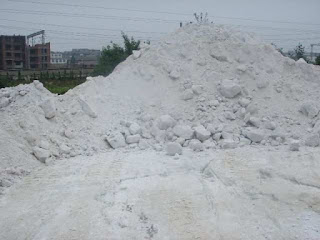Mineral beneficiation-ore comminution
The operation of applying a force on the particle
to break it is called size reduction.
Sinonine deeply know that Comminution is a general term for size reduction that may
be applied without regard to the actual breakage mechanism involved.
In any industrial comminution operation, the
breakage of any individual particle is occurring simultaneously with that of
many other particles. The breakage product of any particle is intimately mixed
with those of other particles. Thus an industrial comminution operation can be
analyzed only in terms of a distribution of feed particles and product
particles. However, each individual particle breaks as a result of the stresses
applied to it and it alone.
1 FRACTURE
Fracture in the particle occurs as a result of
application of a force. When a force is applied on a particle, stress will
develop within the particle. When this stress exceeds ultimate stress, the
particle will break. Let us consider a particle subjected to two opposing forces
by a concentrated load as shown in Figure 1.
Figure 1 Compressive forces.
The principal stress in the z-direction is a
compressive stress throughout the particle. The principal stress in the x- and
y-directions is a compressive stress adjacent to the load points but a tensile
stress within the particle. This tensile stress is lower than compressive
stress. As the tensile strength is as little as 1/10 of compressive strength,
the fracture occurs primarily because of the
tensile stress which results in breakage into a small number of large pieces.
Due to the compression adjacent to the loading points, it results a large
number of small pieces.
Compressive force can be applied at either a fast
or a slow rate. Under the conditions of slow compression, energy applied is
just sufficient to load comparatively few regions of the particle to the
fracture point and only a few particles result. Their size is comparatively
close to the original particle size. Under the conditions of rapid loading such
as in high velocity impact, applied energy is well in excess of that required
for fracture. Many areas in the particle are overloaded and the result is a comparatively
large number of particles with a wide size distribution. Impact causes
immediate fracture with no residual stresses.
Attrition or abrasion fracture occurs when a force
(shear force) acts parallel to the surface of the particle. Due to insufficient
energy applied on the particle, localized stress occurs and a small area is
fractured to give very fine particles.
Another type of fracture is chipping. In this chipping,
the edges or corners of a particle will break due to the application of oblique
forces, generally impact forces, on the particle.
In practice, these events do not occur in
isolation. For example, when the particles are crushed by compression as in the
case of a crusher, coarse particles will be produced resulting from the induced
tensile stress, fine particles will be produced resulting from compressive
stress near the points of loading and by attrition due to particle interaction.
All these types of forces and fractures, and sizes of the particles after
fracture, are shown in Figure 2.
Figure 2. Mechanism of fracture.
It can be summarized that all types of forces exist
in any size reduction operation even though individual size reduction units are
predominantly designed for application of one type of force.
2. OBJECTIVES OF COMMINUTION
The following are some of the objectives of
comminution:
1 Reduction of large lumps into small pieces.
2 Production of solids of desired size range.
3 Liberation of valuable minerals from gangue
minerals.
4 Preparation of feed material for different
beneficiation operations.
5 Increasing the surface area for chemical
reaction.
6 Convenience in handling and transportation.
The energy consumed for the comminution operation
is high when compared to other operations such as screening, beneficiation,
dewatering, conveying etc. In Mineral and Mining Industries. Hence attention
needs to be paid to minimize the production of fines (finer than required) which
will consume additional power for reducing to fines.
3.TYPES OF COMMINUTION OPERATIONS
The run-of-mine ore is quite coarse and cannot be
reduced to fine size in one stage. It may require three or more stages. Each
stage requires separate equipment. The comminution operations are divided into
two broad groups as follows:
1.Crushing
Crushing
is a size reduction operation wherein large lumps are reduced to fragments or
smaller particles.
2.Grinding
Grinding is considered as size reduction of
relatively coarse particles to the ultimate fineness.
The machines used for crushing and grinding are entirely
different. It is to be noted that the energy required for comminution of unit
mass of smaller particles is more than the energy required for unit mass of
coarser particles. However, the energy required to reduce coarser particle is
more than that of smaller particle. Hence the machines used for crushing
(crushers) must be massive and rugged and the machines used for grinding
(mills) must be capable of dispersing energy over a large area. In crushers,
the breakage forces are applied either by compression or impact whereas in grinding
mills shear forces are predominantly applied.
sinonine can also provide sand washing plant epc.



评论
发表评论